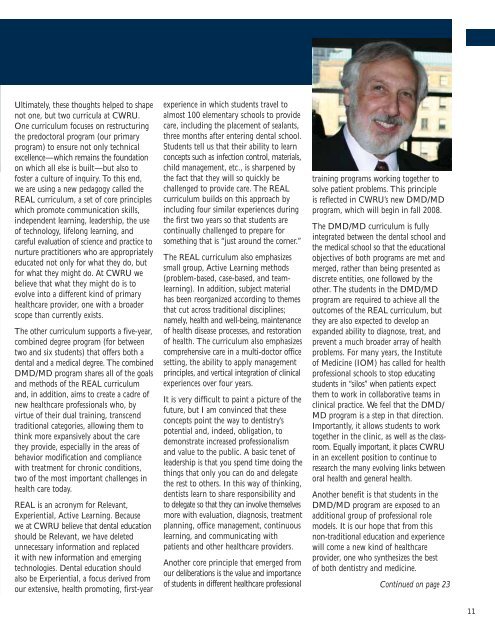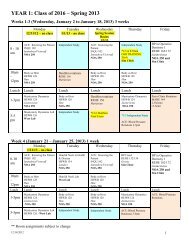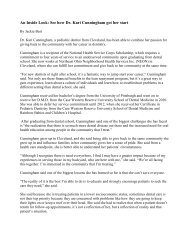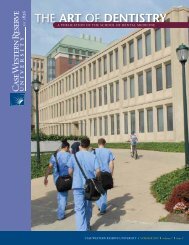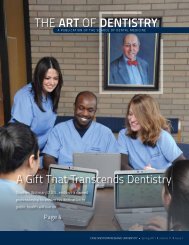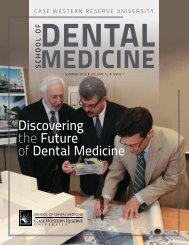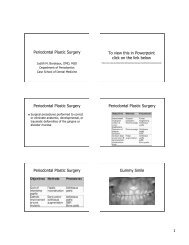THE ART OF DENTISTRY - School of Dental Medicine - Case ...
THE ART OF DENTISTRY - School of Dental Medicine - Case ...
THE ART OF DENTISTRY - School of Dental Medicine - Case ...
You also want an ePaper? Increase the reach of your titles
YUMPU automatically turns print PDFs into web optimized ePapers that Google loves.
Ultimately, these thoughts helped to shape<br />
not one, but two curricula at CWRU.<br />
One curriculum focuses on restructuring<br />
the predoctoral program (our primary<br />
program) to ensure not only technical<br />
excellence—which remains the foundation<br />
on which all else is built—but also to<br />
foster a culture <strong>of</strong> inquiry. To this end,<br />
we are using a new pedagogy called the<br />
REAL curriculum, a set <strong>of</strong> core principles<br />
which promote communication skills,<br />
independent learning, leadership, the use<br />
<strong>of</strong> technology, lifelong learning, and<br />
careful evaluation <strong>of</strong> science and practice to<br />
nurture practitioners who are appropriately<br />
educated not only for what they do, but<br />
for what they might do. At CWRU we<br />
believe that what they might do is to<br />
evolve into a different kind <strong>of</strong> primary<br />
healthcare provider, one with a broader<br />
scope than currently exists.<br />
The other curriculum supports a five-year,<br />
combined degree program (for between<br />
two and six students) that <strong>of</strong>fers both a<br />
dental and a medical degree. The combined<br />
DMD/MD program shares all <strong>of</strong> the goals<br />
and methods <strong>of</strong> the REAL curriculum<br />
and, in addition, aims to create a cadre <strong>of</strong><br />
new healthcare pr<strong>of</strong>essionals who, by<br />
virtue <strong>of</strong> their dual training, transcend<br />
traditional categories, allowing them to<br />
think more expansively about the care<br />
they provide, especially in the areas <strong>of</strong><br />
behavior modification and compliance<br />
with treatment for chronic conditions,<br />
two <strong>of</strong> the most important challenges in<br />
health care today.<br />
REAL is an acronym for Relevant,<br />
Experiential, Active Learning. Because<br />
we at CWRU believe that dental education<br />
should be Relevant, we have deleted<br />
unnecessary information and replaced<br />
it with new information and emerging<br />
technologies. <strong>Dental</strong> education should<br />
also be Experiential, a focus derived from<br />
our extensive, health promoting, first-year<br />
experience in which students travel to<br />
almost 100 elementary schools to provide<br />
care, including the placement <strong>of</strong> sealants,<br />
three months after entering dental school.<br />
Students tell us that their ability to learn<br />
concepts such as infection control, materials,<br />
child management, etc., is sharpened by<br />
the fact that they will so quickly be<br />
challenged to provide care. The REAL<br />
curriculum builds on this approach by<br />
including four similar experiences during<br />
the first two years so that students are<br />
continually challenged to prepare for<br />
something that is “just around the corner.”<br />
The REAL curriculum also emphasizes<br />
small group, Active Learning methods<br />
(problem-based, case-based, and teamlearning).<br />
In addition, subject material<br />
has been reorganized according to themes<br />
that cut across traditional disciplines;<br />
namely, health and well-being, maintenance<br />
<strong>of</strong> health disease processes, and restoration<br />
<strong>of</strong> health. The curriculum also emphasizes<br />
comprehensive care in a multi-doctor <strong>of</strong>fice<br />
setting, the ability to apply management<br />
principles, and vertical integration <strong>of</strong> clinical<br />
experiences over four years.<br />
It is very difficult to paint a picture <strong>of</strong> the<br />
future, but I am convinced that these<br />
concepts point the way to dentistry’s<br />
potential and, indeed, obligation, to<br />
demonstrate increased pr<strong>of</strong>essionalism<br />
and value to the public. A basic tenet <strong>of</strong><br />
leadership is that you spend time doing the<br />
things that only you can do and delegate<br />
the rest to others. In this way <strong>of</strong> thinking,<br />
dentists learn to share responsibility and<br />
to delegate so that they can involve themselves<br />
more with evaluation, diagnosis, treatment<br />
planning, <strong>of</strong>fice management, continuous<br />
learning, and communicating with<br />
patients and other healthcare providers.<br />
Another core principle that emerged from<br />
our deliberations is the value and importance<br />
<strong>of</strong> students in different healthcare pr<strong>of</strong>essional<br />
training programs working together to<br />
solve patient problems. This principle<br />
is reflected in CWRU’s new DMD/MD<br />
program, which will begin in fall 2008.<br />
The DMD/MD curriculum is fully<br />
integrated between the dental school and<br />
the medical school so that the educational<br />
objectives <strong>of</strong> both programs are met and<br />
merged, rather than being presented as<br />
discrete entities, one followed by the<br />
other. The students in the DMD/MD<br />
program are required to achieve all the<br />
outcomes <strong>of</strong> the REAL curriculum, but<br />
they are also expected to develop an<br />
expanded ability to diagnose, treat, and<br />
prevent a much broader array <strong>of</strong> health<br />
problems. For many years, the Institute<br />
<strong>of</strong> <strong>Medicine</strong> (IOM) has called for health<br />
pr<strong>of</strong>essional schools to stop educating<br />
students in “silos” when patients expect<br />
them to work in collaborative teams in<br />
clinical practice. We feel that the DMD/<br />
MD program is a step in that direction.<br />
Importantly, it allows students to work<br />
together in the clinic, as well as the classroom.<br />
Equally important, it places CWRU<br />
in an excellent position to continue to<br />
research the many evolving links between<br />
oral health and general health.<br />
Another benefit is that students in the<br />
DMD/MD program are exposed to an<br />
additional group <strong>of</strong> pr<strong>of</strong>essional role<br />
models. It is our hope that from this<br />
non-traditional education and experience<br />
will come a new kind <strong>of</strong> healthcare<br />
provider, one who synthesizes the best<br />
<strong>of</strong> both dentistry and medicine.<br />
Continued on page 23<br />
11


